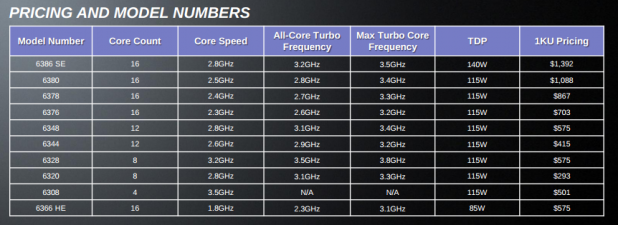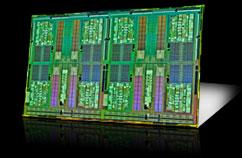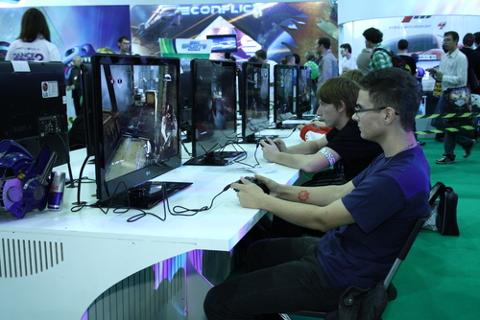 Opteron 6300 pricing.[/caption] Advanced Micro Devices has announced its Opteron 6300 microprocessor, also known as the “Abu Dhabi” core. The new Opteron chip, based on the new “Piledriver” core architecture, will compete with Intel’s Xeon chips on a combination of performance, power, and especially price. Over 30 platforms based on the new chip are expected from customers like Cray, Dell, HP, and SGI, said executives from AMD. According to AMD, the 6300 represents roughly a 40 percent increase in performance per watt over the previous 6200 generation. However, the chips maintain the same thermal specifications and socket. The 6300 scales up to 4 sockets with 16 cores, with clock speeds mixed and matched for single-threaded versus multiple-thread workloads: for example, the 6308 is a 4-core chip that runs at 3.4 GHz, while at the high end, the 6386SE runs at 2.8 GHZ with 16 cores. Power bands range from the 6366 HE (1.8 GHz, 16 cores, 85 watts) up to the 6386SE at 140 watts. All of the other chips run at 115 watts. Turbo Core can ramp up the clock speed by a few hundred megahertz where thermals allow. Four DDR-3 channels allow up to 1.5 TB of 1866-MHz RAM in 4P configurations. Each core links to 4x16 HT 3.0 connections. AMD's new Piledriver core also supports the Fused Multiple Add 3 (FMA3) instructions shared between AMD and Intel; Bit Manipulation Instructions from AMD and Intel, plus Trailing Bit Instructions from AMD for bit manipulatiion operations; and F16c floating-point conversions.
Opteron 6300 pricing.[/caption] Advanced Micro Devices has announced its Opteron 6300 microprocessor, also known as the “Abu Dhabi” core. The new Opteron chip, based on the new “Piledriver” core architecture, will compete with Intel’s Xeon chips on a combination of performance, power, and especially price. Over 30 platforms based on the new chip are expected from customers like Cray, Dell, HP, and SGI, said executives from AMD. According to AMD, the 6300 represents roughly a 40 percent increase in performance per watt over the previous 6200 generation. However, the chips maintain the same thermal specifications and socket. The 6300 scales up to 4 sockets with 16 cores, with clock speeds mixed and matched for single-threaded versus multiple-thread workloads: for example, the 6308 is a 4-core chip that runs at 3.4 GHz, while at the high end, the 6386SE runs at 2.8 GHZ with 16 cores. Power bands range from the 6366 HE (1.8 GHz, 16 cores, 85 watts) up to the 6386SE at 140 watts. All of the other chips run at 115 watts. Turbo Core can ramp up the clock speed by a few hundred megahertz where thermals allow. Four DDR-3 channels allow up to 1.5 TB of 1866-MHz RAM in 4P configurations. Each core links to 4x16 HT 3.0 connections. AMD's new Piledriver core also supports the Fused Multiple Add 3 (FMA3) instructions shared between AMD and Intel; Bit Manipulation Instructions from AMD and Intel, plus Trailing Bit Instructions from AMD for bit manipulatiion operations; and F16c floating-point conversions.
AMD's New Opteron 6300 Optimized for TCO
[caption id="attachment_5678" align="aligncenter" width="618"]  Opteron 6300 pricing.[/caption] Advanced Micro Devices has announced its Opteron 6300 microprocessor, also known as the “Abu Dhabi” core. The new Opteron chip, based on the new “Piledriver” core architecture, will compete with Intel’s Xeon chips on a combination of performance, power, and especially price. Over 30 platforms based on the new chip are expected from customers like Cray, Dell, HP, and SGI, said executives from AMD. According to AMD, the 6300 represents roughly a 40 percent increase in performance per watt over the previous 6200 generation. However, the chips maintain the same thermal specifications and socket. The 6300 scales up to 4 sockets with 16 cores, with clock speeds mixed and matched for single-threaded versus multiple-thread workloads: for example, the 6308 is a 4-core chip that runs at 3.4 GHz, while at the high end, the 6386SE runs at 2.8 GHZ with 16 cores. Power bands range from the 6366 HE (1.8 GHz, 16 cores, 85 watts) up to the 6386SE at 140 watts. All of the other chips run at 115 watts. Turbo Core can ramp up the clock speed by a few hundred megahertz where thermals allow. Four DDR-3 channels allow up to 1.5 TB of 1866-MHz RAM in 4P configurations. Each core links to 4x16 HT 3.0 connections. AMD's new Piledriver core also supports the Fused Multiple Add 3 (FMA3) instructions shared between AMD and Intel; Bit Manipulation Instructions from AMD and Intel, plus Trailing Bit Instructions from AMD for bit manipulatiion operations; and F16c floating-point conversions.
Opteron 6300 pricing.[/caption] Advanced Micro Devices has announced its Opteron 6300 microprocessor, also known as the “Abu Dhabi” core. The new Opteron chip, based on the new “Piledriver” core architecture, will compete with Intel’s Xeon chips on a combination of performance, power, and especially price. Over 30 platforms based on the new chip are expected from customers like Cray, Dell, HP, and SGI, said executives from AMD. According to AMD, the 6300 represents roughly a 40 percent increase in performance per watt over the previous 6200 generation. However, the chips maintain the same thermal specifications and socket. The 6300 scales up to 4 sockets with 16 cores, with clock speeds mixed and matched for single-threaded versus multiple-thread workloads: for example, the 6308 is a 4-core chip that runs at 3.4 GHz, while at the high end, the 6386SE runs at 2.8 GHZ with 16 cores. Power bands range from the 6366 HE (1.8 GHz, 16 cores, 85 watts) up to the 6386SE at 140 watts. All of the other chips run at 115 watts. Turbo Core can ramp up the clock speed by a few hundred megahertz where thermals allow. Four DDR-3 channels allow up to 1.5 TB of 1866-MHz RAM in 4P configurations. Each core links to 4x16 HT 3.0 connections. AMD's new Piledriver core also supports the Fused Multiple Add 3 (FMA3) instructions shared between AMD and Intel; Bit Manipulation Instructions from AMD and Intel, plus Trailing Bit Instructions from AMD for bit manipulatiion operations; and F16c floating-point conversions.
 Opteron 6300 pricing.[/caption] Advanced Micro Devices has announced its Opteron 6300 microprocessor, also known as the “Abu Dhabi” core. The new Opteron chip, based on the new “Piledriver” core architecture, will compete with Intel’s Xeon chips on a combination of performance, power, and especially price. Over 30 platforms based on the new chip are expected from customers like Cray, Dell, HP, and SGI, said executives from AMD. According to AMD, the 6300 represents roughly a 40 percent increase in performance per watt over the previous 6200 generation. However, the chips maintain the same thermal specifications and socket. The 6300 scales up to 4 sockets with 16 cores, with clock speeds mixed and matched for single-threaded versus multiple-thread workloads: for example, the 6308 is a 4-core chip that runs at 3.4 GHz, while at the high end, the 6386SE runs at 2.8 GHZ with 16 cores. Power bands range from the 6366 HE (1.8 GHz, 16 cores, 85 watts) up to the 6386SE at 140 watts. All of the other chips run at 115 watts. Turbo Core can ramp up the clock speed by a few hundred megahertz where thermals allow. Four DDR-3 channels allow up to 1.5 TB of 1866-MHz RAM in 4P configurations. Each core links to 4x16 HT 3.0 connections. AMD's new Piledriver core also supports the Fused Multiple Add 3 (FMA3) instructions shared between AMD and Intel; Bit Manipulation Instructions from AMD and Intel, plus Trailing Bit Instructions from AMD for bit manipulatiion operations; and F16c floating-point conversions.
Opteron 6300 pricing.[/caption] Advanced Micro Devices has announced its Opteron 6300 microprocessor, also known as the “Abu Dhabi” core. The new Opteron chip, based on the new “Piledriver” core architecture, will compete with Intel’s Xeon chips on a combination of performance, power, and especially price. Over 30 platforms based on the new chip are expected from customers like Cray, Dell, HP, and SGI, said executives from AMD. According to AMD, the 6300 represents roughly a 40 percent increase in performance per watt over the previous 6200 generation. However, the chips maintain the same thermal specifications and socket. The 6300 scales up to 4 sockets with 16 cores, with clock speeds mixed and matched for single-threaded versus multiple-thread workloads: for example, the 6308 is a 4-core chip that runs at 3.4 GHz, while at the high end, the 6386SE runs at 2.8 GHZ with 16 cores. Power bands range from the 6366 HE (1.8 GHz, 16 cores, 85 watts) up to the 6386SE at 140 watts. All of the other chips run at 115 watts. Turbo Core can ramp up the clock speed by a few hundred megahertz where thermals allow. Four DDR-3 channels allow up to 1.5 TB of 1866-MHz RAM in 4P configurations. Each core links to 4x16 HT 3.0 connections. AMD's new Piledriver core also supports the Fused Multiple Add 3 (FMA3) instructions shared between AMD and Intel; Bit Manipulation Instructions from AMD and Intel, plus Trailing Bit Instructions from AMD for bit manipulatiion operations; and F16c floating-point conversions.


